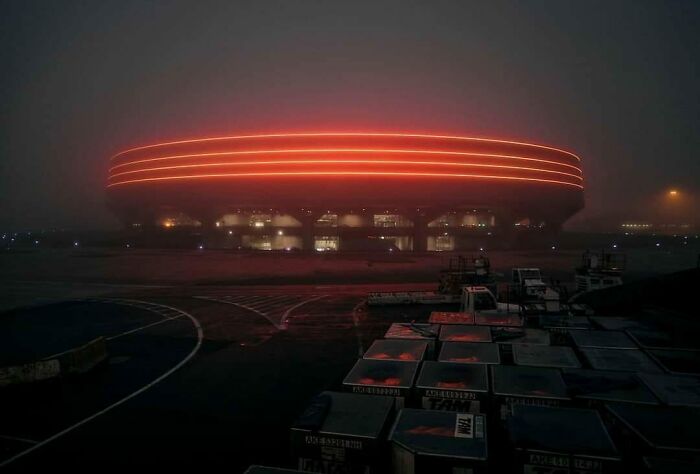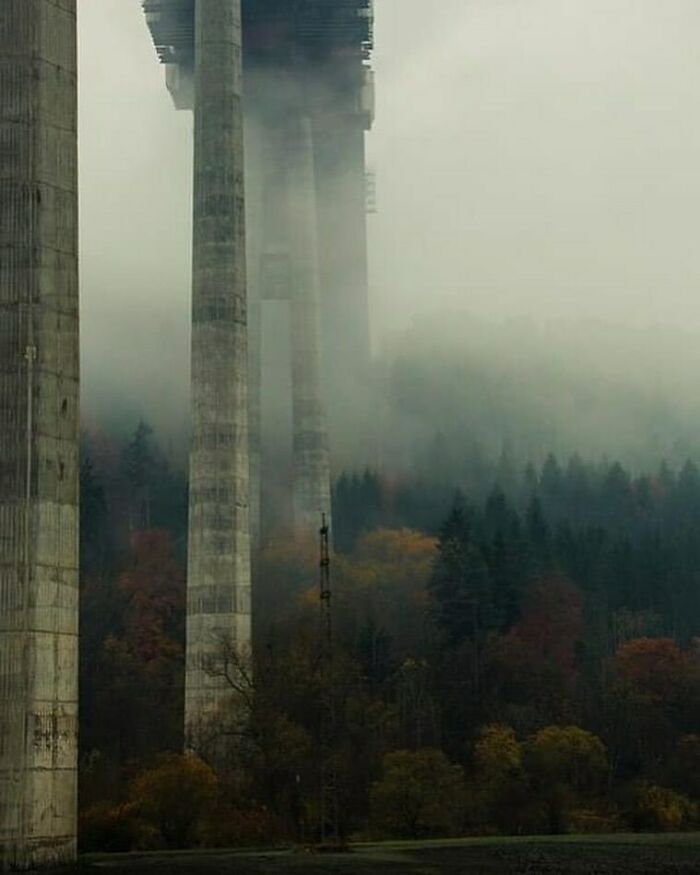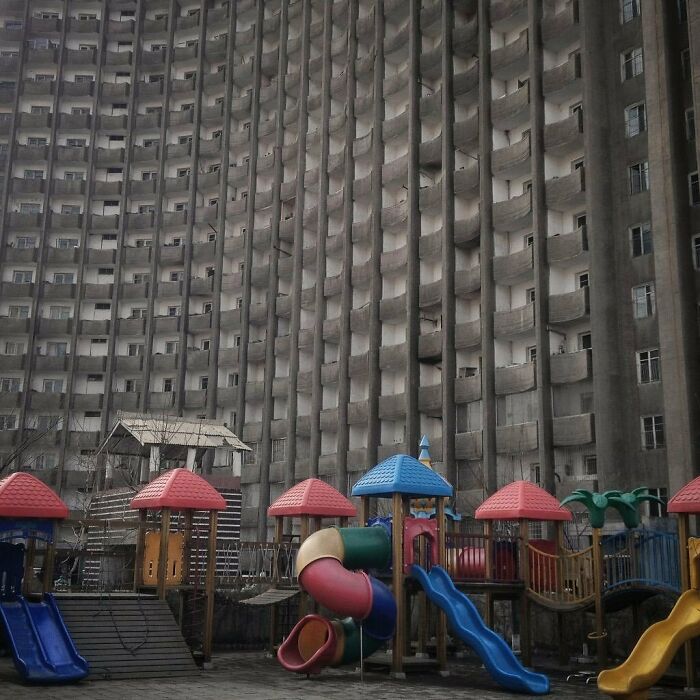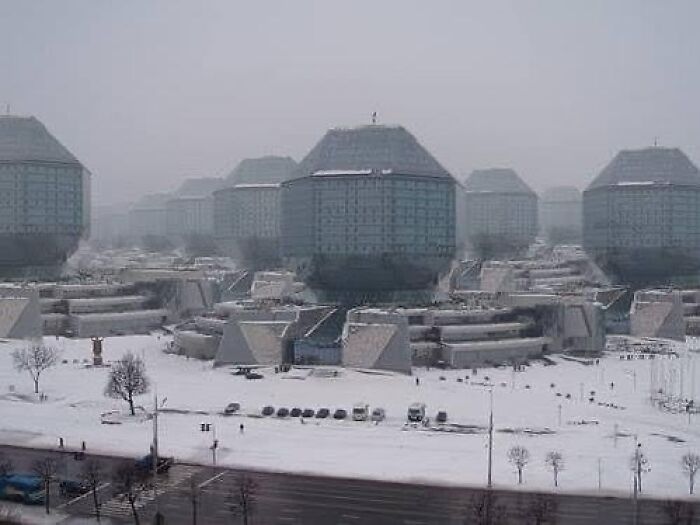
30 Pics That Perfectly Sum Up Brutalist Architecture, As Shared On This Online Page (New Pics)
Welcome to brutalism, probably the most divisive aesthetic humanity has created yet. Some may call it ugly and uninspiring. Others believe there are lots of possibilities for creativity using its aesthetics. But whether you’re a lover or a hater, you can’t deny it’s an influential architectural and aesthetic style.
The creators of this IG page also know this, as they are a part of the SocialistModernism project. The Brut Group Instagram is part of the project’s attempt to fight for “the acknowledgment of certain socialist landmarks as historic monuments.” As they continue to do that, Brut Group is a place for examples of brutalist architecture from all over the world, not just the former Eastern Bloc. We’ve prepared a new selection of pics from this IG page for you, Pandas, so scroll down and let us know your favorites.
This post may include affiliate links.
I really like this one. It's visually interesting and all the curves somewhat soften the overall hard, concrete look.
The Aul Residential Complex, Almaty, Kazakhstan 1986-2002
Load More Replies...It would make a fabulous movie location. Very atmospheric. I am seeing a sort of communist era Rear Window.
London Aquatics Centre for the 2012 Summer Olympics. Brutalist architecture??? https://www.archdaily.com/161116/london-aquatics-centre-for-2012-summer-olympics-zaha-hadid-architects
So, it's Zaha Hadid. Thank's for your comments, there is not much value in photographs with no explanation, especially if lots of photos out of topic. Upvote, by the way.
Load More Replies...Not a single thing out of place, and everything perfectly lined up - what's not to love....??
Interesting effect of juxtaposition, the massive boulder with the bubbly foreground. I can’t decide if I like it.
The Socialist Modernism page is an initiative developed by BACU – Birou pentru Artă şi Cercetare Urbană (Bureau for Art and Urban Research). It's an architectural heritage protection community based in Romania. As already mentioned, their goal is to protect built heritage and research within the former Eastern Bloc. Their focus is on the buildings erected between 1955 and 1991.
"We are dealing with the protection/monitoring/research/preservation of the current state of those cities," the group writes on its website. That includes buildings, monuments, parks, squares, entire districts, and green areas.
Some bushes and trees and I would find this totally acceptable. I like the swirls.
It does look like the photo was taken prior to the landscaping being completed.
Load More Replies...The decorative concrete design on the exterior doesn't strike me as fitting in with the Brutalist sensibility.
Bonaventure Hotel in Los Angeles, CA. It reminds me of a hotel in Detroit that has something like this structure. It also has glass walkways.
Could also be the Renaissance Center in Detroit. Probably the same architect. It's famous for getting people lost in it.
Same architect, all right - also did the Peachtree Plaza Hotel in Atlanta.
Load More Replies...I’m going to harangue the masses, just as soon as I finish this muffin
They describe the process of their work too: "In the first phase of this project, we will concentrate on the analysis/research/study." The second phase will involve the education of local authorities and inhabitants of those protected areas. They seek the protection of brutalist buildings through legislation.
If you go to the Modernist Socialism website, you can find an interactive map. It shows brutalist buildings from all over the world that architects, urban planners, art historians, and activists have submitted to the project.
Naples. It's the "Casa del Portuale" ("dockworker's house"), built as the headquarters for the company providing services to the port administration, it housed the union of dockworkers, as well as a social center for the employees.
Load More Replies...This is the reason we have nuclear weapons and why aliens haven't visited )
Casa del Portuale, Napoli, Italy. https://www.domusweb.it/en/architecture/2022/03/18/the-signs-of-neglect-on-aldo-loris-rossis-architecture.html
I see less Brutalism and more "Fallingwater" by way of Art Nouveau.
Just waiting for Ellen Ripley to pop her head round....
Load More Replies...Although the website's mission statement focuses on former Soviet Union countries, the map also includes buildings from other continents.
Some entries are more or less what you'd expect, The Embassy of the Russian Federation in Cuba, for example. But there are other interesting examples, too. The Geisel Library of the University of California in San Diego might be a more surprising listing.
well.. it IS a terminal at an Airport (CDG airport, Paris)
Load More Replies...Close to a LEGO structure my son made recently -- I thought the same about his...
Load More Replies...This looks like the cover of a Molchat Doma album (it might be?)
Hotel Panorama? The view had better have been good to make up for staying in this dreary place
This is a ski resort in the Tatra mountains in Slovakia, still open. https://shorturl.at/twEWY
Load More Replies...To me it looks like blocks being stacked on top of each other.
what does brutal even mean anymore? *lacking a Google search on purpose*
St. Francis de Sales Catholic Church Norton Shores, Michigan https://www.michiganmodern.org/modern-buildings/saint-francis-de-sales-church/
The origins of the term 'brutalism' come from the French language. 'Béton brut' means 'raw concrete,' referring to the material most architects and designers of the movement used. Brutalism came into prominence in the '50s and '60s. Art historians characterize it as simple, block-like forms and constructions from raw concrete.
Who starts to build a hotel or a building then stops? Someone is losing a lot of money. Also a waste of money.
Compared to the straight block buildings nowadays, at lest this has some texture!
Looks like one of those bean bag toss things where you get a prize for getting the bag in a slot.
Is this modern art or does it actually have a function? Excessive waste of money, as far as I can see
Definitely see a Tie Fighter here. Quite wide..maybe Darth Vaders experimental TIE fighter.
Oh I know this one but can't for the life of me remember where it's from exactly
Monument to the Revolution of the People of Moslavina
Load More Replies...Oh hey, it's that place where Alan Walker went for the song 'Darkside'
There's another theory of how brutalism came to be. New Brutalism, to be exact. Peter Smithson, one of the pioneers of British brutalism, apparently resembled the emperor Brutus. His nickname was Brutus, and people thus theorize that's where the name for the style came from.
This photograph appears to be from March 2004. Some updated pics, internal & external, are included in this article from Jul 2023 https://www.9news.com.au/world/ryugyong-hotel-north-korea-the-hotel-of-doom-that-has-never-welcomed-a-single-guest/0f1f16df-65bc-41a3-9c79-dc6d9de2afed
Never completed it. Never furnished the rooms. Oops! Looked good on paper.
It's true that, often, people either love or hate brutalist architecture. Usually, it's because the style lacks ornaments and colors. It's like a blank canvas, and the buildings look unfinished, in a way. But Urban Learners Director Andy Costa says that it's a "misnomer that brutalist buildings have no articulation."
i don't know what brutalist means, on purpose. Although this picture is one of the few here I would think it does. Might be completely wrong, but I think no one gives a ?@$# either way...
Look! It's the spirit of any lovely architecture style being exorcized from the building!
That's not brutalism, that's just a concrete apartment building left unfinished.
Neckar Viaduct? not quite as imposing when seen in regular daylight without all the fog xP
"They're really full of texture and life," the architecture and development consultant went on to say in his interview with BBC Front Row. He also spoke about the reasons why so many buildings from that time in Britain and Eastern Europe had the brutalist style. "Concrete was cheap, [and] energy was cheap at the time," he simply said. "It was a very affordable material."
Adding that play area just makes the whole thing sadder and more depressing to look at.
These are actually kind of cool now that they've settled in. Stackable, with garden spaces scattered about. https://www.mtl.org/en/experience/revolutionary-montreal-icon-habitat-67
Montréal, probably the most desirable (not necessarily best) condo's in town.
This is a bit shopped. There is actually only one of these buildings.
Not brutalism. This is the National Library of Belarus in Minsk, but the picture is photoshopped.
Minsk in Belarus. This is photoshopped though, there's only 1. I've seen it and it isn't too bad in real life considering where it is.
Load More Replies...However, cost practicality is not the only quality of brutalism. There's also a philosophical aspect. "It wasn't rendered or covered brick. It didn't present itself as something better than it actually was," Costa added. "There's real honesty about that. And the philosophers and critics of that time taught about that ethic of architecture being accessible buildings."
Thank you for making me laugh out loud on a Thursday afternoon!
Load More Replies...I like this so much better than the St. Francis de Sales church in Michigan. I bet it echoes like crazy, though.
Kinda spare attendance for … holy communion. Guess not many people care.
Banco de Londres es una obra de Clorindo Testa construdia en Buenos Aires, Argentina en el año 1959 - 1966, still standing and being a bank
i like this, where is this? edit: bank of London and South america, Argentina
Sunbathing means lying in the sun. A beach is not required. I hate it, but a lot of people really enjoy just lying in the sun.
Load More Replies...The openings in the building on the left look like they were punched out. They're so irregular.
Catherine Croft, Director of the Twentieth Century Society, spoke to BBC Front Row about how brutalism was a response to modernism. "People felt it got a bit too staged, too boring, and a bit too bland."
Because the majority of brutalist buildings are in former socialist states, people assume that there are socialist principles behind the style itself. We only need to look at what types of buildings these were: mostly residential.
Nothing to do with brutalism. This is a Norwegian oil platform in the North Sea.
But Croft gives examples of commercial buildings in Britain as evidence that brutalist buildings are always socialist. There are many car parks and shopping centers of this style, she says. One of them is the Tricorn Centre in Portsmouth. "There was nothing socially ambitious about those," Croft says. "They were designed to make money."
The picture is amazing. These are still used to this day. But again, this is not brutalist architecture!
Reminds me of stapler refills :-) But seriously, this is pretty nice. It's sad that it's abandoned.
This is at the peak of Mount Sněžka. The border between Poland and the Czech Republic runs across the peak. The photo is taken from the Czech side and shows the weather research station on the Polish side.
There is always a way to get past the guards in these levels. Look for a sewer grate.
Amazing they even bothered with a little bit of colour in the playground
This was the Information desk inside the TWA Terminal at New York's JFK Airport in 1962
Yup, by architect Eero Saarinen. After sitting empty for years reopened in 2019 as the TWA hotel. They also have a Super Constellation parked in front of it.
Load More Replies...There's an electro album cover using that pic. I can't remember the band
These were "le Vele di Scampia", four residential buildings built between 1962-75 near Milan. They never lived up to their design and, as they decayed they were occupied by progressively poorer people and became a hive of gang activity. They were finally torn down starting in 1997 with the last one, which had been derelict for years, in 2020.
This is a fountain in Como, Italy, dated 1935 designed by Cesare Cattaneo
isnt this the University in Delft? I know ive seen it before. edit: yes! *pats self on shoulder*
Corviale is an housing projects built in Rome in the 1970's It was conceived as an independent community for about 8000 people.
Like the concept, but not the execution. Giving serious dystopian vibes.
It's sad these monuments were lost to "progress". What were we progressing towards? A boring future?
one of my favorites. Hotel Uzbekistan. looks like a giant bent amp :-D
Belarus. obviously inspired by the similar one in Tokyo thats been torn down :-(
Wave breakers to prevent beach erosion. There are tons of them being put near where I live. An eyesore, but a necessary one.
Load More Replies...I wonder how many mammals end up dying because they fall in and can't get out?
Let me know where this is. I've been looking for a place to wait out the zombie apocalypse.
Doesn't look quite so brutal in miniature. Maybe some of the brutal effect resides in size or repetition, both contributing to distain for humans
This is an underground reservoir to take water from storms, I think? It's more built to be 100% functional than an example of brutal architalecture.
It's not "brutal", it's "brutalist". It's a specific style of architecture which features large areas of exposed concrete, and this one definitely qualifies. Some of the others on this list, ironically, don't.
Load More Replies...That, or this is the gateway to space when you're in a tie fighter.
Load More Replies...Saint Joseph Church in Le Havre, Normandy, France. Lived 200 m from it for 5 years. The light inside is trully wonderful. Architect: Auguste Perret, circa 1950
It's Johannesburg. When it was built White families lived in the outside apartments and black servants lived in the internal apartments attached to them. AS grim as it looks now, it was morally a lot grimmer when it was a luxury building.
The same as above but from another angle... I feel sorry for the people at the first couple of levels of this apartments. They must have trash instead of windows.
I don't think anyone *legally* lives in the building - it's mainly just squatters.
Load More Replies...You are right, by definition Brutalist is exposed concrete, as in Béton Brut, so I'd say no it isn't. It is Atom Age architecture.
Load More Replies...oh wow, I love the Atomium and never seen this pic! And no, its not brutalism. Brutalism has nothing to do with "Brutal"
Where is this building? How did the fire start? What happened to it after the fire?
google says its the UNIS towers in Sarajevo and this is during the war. Towers survived,no idea if theyrer still there.
Load More Replies...Again, not brutalism, this is an art style called "Socialist-realist". Ironically, despite the name there's a lot of allegorical subjects and the actual sculptures tend to have a lot of angular and exagerated features etc.
Not ADA-compliant. Should have put in a wheelchair ramp. (Ramp would take quite an effort to roll up, but be quite exciting coming down)
There's a very good reason it's not ADA-compliant. It's not in the USA, and therefore the USA's planning/construction laws do not apply. This is the State Circus, (lateral interior stair) in Baku, Azerbaijan,
Load More Replies...It's the Monument to Victims of the Holocaust by Hans Hollein. This is just a drawing, the monument was never built.
Is it Brutalist? By definition Brutalist is exposed concrete, as in Béton Brut
theres a similar one in Wuppertal, Germany, totally safe.
Load More Replies...Olafur Eliasson's art installation at the Tate Modern turbine hall in London
I remember going to see this. It was weird. People were lying down, “sunbathing” as it had that effect on you.
And you guessed wrong, it's an open pit diamond mine in Mirny, Sakha Republic, Russia
Load More Replies...It's an open pit diamond mine in Mirny, Sakha Republic, Russia. The town was built in the Soviet period specifically to house the workers for the mine.
Load More Replies...I am impressed, a list about brutalist architecture that maybe shows a handful examples, the rest being random old or ugly buildings. Bravo
TIL: 1. Star Wars' empire used brutalism as inspiration & 2: BP doesn't know what brutalism is
Internet becoming less appealing place now. It was easy to learn something, several years before. I thought it smells like evolution, less stupid ppl overall, education at the tip of your fingers, if you want it. And now disinformation everywhere, useful sources misplaced with attempts to sell something. Even the pictures of well known artists, are replaced with AI images. Guys, the only architecture post in a month, with a glass, burning building, you labeled Brutalism.
first of all, why didnt they say where these are taken, second of all, as several people already said, most of these have nothing to do with brutalism. Brutalism has nothing t do with "brutal"
We clearly have Pandas who could put together a better list than this - any volunteers?
too lazy, but for a quick fix, google Alexandra estate, Trellick Tower, Balfron tower, Barbican, the Standard hotel, all in London, for a few fun brutalist examples!
Load More Replies...Likely alone in this view: add some windows and a s**t load of greenery and I'm in love with the majority of these🥰
Brutalism may have looked good on the plans but living in them was awful, this is why no one likes it. Some were practical as a means of alleviating overcrowding in the 60s and were quick to build and much cheaper than refurbishing existing stock. Now they are coming down having reached the end of their lives after 50/60 years..
some of these social housing estates were build (not designed) too cheap, and not looked after well, because poor people lived in them.
Load More Replies...I am impressed, a list about brutalist architecture that maybe shows a handful examples, the rest being random old or ugly buildings. Bravo
TIL: 1. Star Wars' empire used brutalism as inspiration & 2: BP doesn't know what brutalism is
Internet becoming less appealing place now. It was easy to learn something, several years before. I thought it smells like evolution, less stupid ppl overall, education at the tip of your fingers, if you want it. And now disinformation everywhere, useful sources misplaced with attempts to sell something. Even the pictures of well known artists, are replaced with AI images. Guys, the only architecture post in a month, with a glass, burning building, you labeled Brutalism.
first of all, why didnt they say where these are taken, second of all, as several people already said, most of these have nothing to do with brutalism. Brutalism has nothing t do with "brutal"
We clearly have Pandas who could put together a better list than this - any volunteers?
too lazy, but for a quick fix, google Alexandra estate, Trellick Tower, Balfron tower, Barbican, the Standard hotel, all in London, for a few fun brutalist examples!
Load More Replies...Likely alone in this view: add some windows and a s**t load of greenery and I'm in love with the majority of these🥰
Brutalism may have looked good on the plans but living in them was awful, this is why no one likes it. Some were practical as a means of alleviating overcrowding in the 60s and were quick to build and much cheaper than refurbishing existing stock. Now they are coming down having reached the end of their lives after 50/60 years..
some of these social housing estates were build (not designed) too cheap, and not looked after well, because poor people lived in them.
Load More Replies...
 Dark Mode
Dark Mode 

 No fees, cancel anytime
No fees, cancel anytime 



































































































































































































